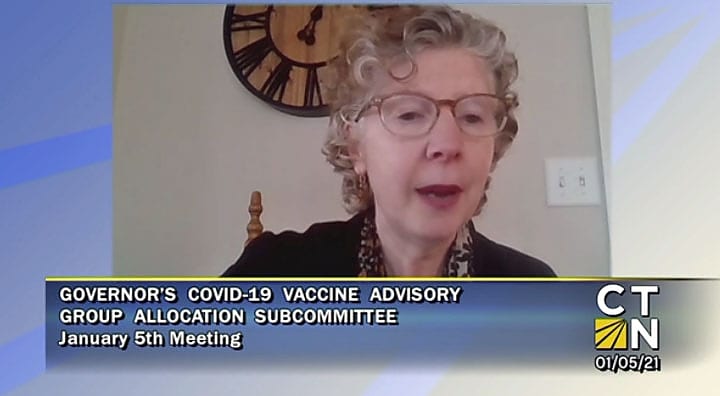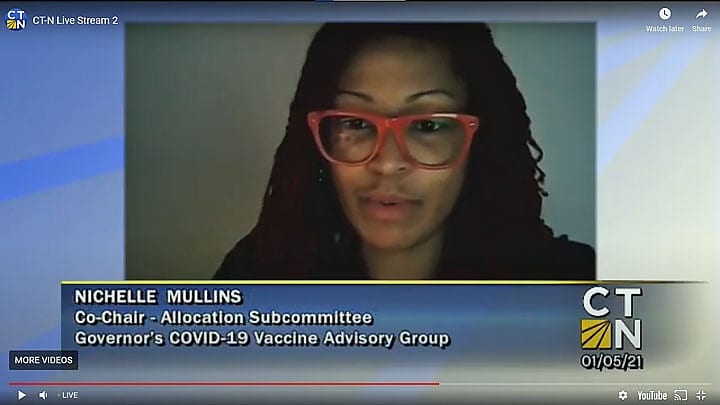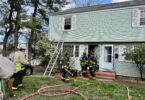Before the panel hit its two-hour meeting deadline Tuesday, the group had agreed that the next phase of vaccinations would include at least people over age 75 and staff and residents of congregate settings.
By Hugh McQuaid, CTNewsJunkie.com
Residents of congregate settings, including prison inmates, and frontline workers were among the groups recommended Tuesday to receive the next round of COVID-19 vaccinations by a state panel during a two-hour meeting that left many questions unanswered.
During the remote meeting, the allocations subcommittee of the state’s COVID-19 Vaccine Advisory Group weighed a host of competing interests as it tried to hammer out recommendations for who will be included in Phase 1B of Connecticut’s vaccine distribution. Although Gov. Ned Lamont has the final say on the vaccine rollout, he has repeatedly indicated he plans to adhere to the group’s recommendations.
During the meeting, Acting Public Health Commissioner Dr. Deidre Gifford said she expects Phase 1B to begin later this month, as soon as demand from the groups included in Phase 1A begins to slow. The state expects to have received about 213,000 doses by the end of this week and estimates there are about 320,000 eligible individuals in Phase 1A, which includes frontline health care workers, nursing home residents, and emergency medical responders.

Acting Public Health Commissioner Deidre Gifford. Photo courtesy of CT-N/CTNewsJunkie.com
Before the panel hit its two-hour meeting deadline, the group had agreed that the next phase of vaccinations would include at least people over the age of 75 years old, as well as the staff and residents of congregate settings. The panel included people incarcerated in Connecticut’s prisons system in addition to residents of homeless shelters and group homes. They also added uncompensated caretakers of elderly people to the next phase.
The panel adopted the Centers for Disease Controls guidance for Phase 1B frontline workers including teachers and grocery store employees as well as public safety and transportation workers.
However, the meeting ended with many groups still in limbo including residents with intellectual and developmental disorders and their caretakers, as well as people under the age of 75 with underlying conditions that make them vulnerable to the coronavirus.
Nichelle Mullins, president of Charter Oak Health Center and co-chairwoman of the subcommittee, ended the meeting by acknowledging the difficult choices the group faced.
“This is not an easy discussion,” she said. “Ultimately, it seems like we’re going to be leaving people out just due to the limited number of the vaccines that we have available and we knew that from the beginning.”
For much of the two-hour meeting the group found itself weighing difficult priorities forced by the high mortality rate afflicting the state’s elderly population and underserved racial groups. They struggled to balance an inclusive approach to the next phase with adding so many groups that none of them received any priority.
At one point in the meeting, Gifford sought to remind the panel that most of the fatalities in Connecticut have been concentrated among its oldest residents.
“I just want to make sure we all have it in our heads as we’re thinking about adding additional large population groups to 1B, that these people will end up, by definition, further down the line than if we keep 1B smaller,” she said.
The population included in Phase 1B is already more than twice the size of those included in the first phase. Between the frontline workers and residents over the age of 75, the second group encompases more than 800,000 people. The panel’s Tuesday decision to include those in congregate settings adds roughly 50,000 more.
The panel grappled with how to address racial and ethnic inequities in Connecticut’s vaccine rollout. Reginald Eadie, CEO of Trinity Health, pointed to data showing higher mortality rates among the state’s African Americans, Hispanics and non-Hispanic Islander populations.
“We can’t ignore this data. If the ultimate goal is to prevent deaths, reach herd immunity. … These are the people that are dying in Connecticut so shame on us if we don’t consider this in that balancing act,” he said.
Throughout the meeting, Sara Parker McKernan, a policy advocate with New Haven Legal Assistance, repeatedly lobbied for the inclusion of people with intellectual and developmental disabilities as well as their caregivers.
“The studies we’ve been given say that they’re the third-highest risk of death if they contract this. I feel really strongly that those are people who need those protections,” she said.
Although no one on the panel directly opposed the idea, it became intertwined in a wider discussion on people under the age of 75 with co-morbidities and the panel was unable to reach a consensus on that group before they ran out of time.
The group agreed to finish finalizing its Phase 1B recommendations as well as draft guidance for Phase 1C at its next meeting, which had not yet been scheduled.
Republished with permission from CTNewsJunkie.com, all rights reserved.
Like what you see here? Click here to subscribe to We-Ha’s newsletter so you’ll always be in the know about what’s happening in West Hartford! Click the blue button below to become a supporter of We-Ha.com and our efforts to continue producing quality journalism.









I’d like to know how to find out how my 80 year old husband can get the vaccine. Is Connecticut even giving the vaccine yet? I can’t tell by reading this article.